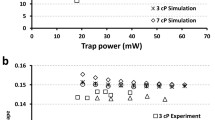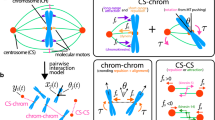Abstract
Two types of unusual motion within the spindle have heen studied in a grasshopper (Melanoplus differentialis) spermatocyte. The first is the motion of granules placed by micromanipulation within the normally granule-free spindle. The most specific motions are poleward, approximate the speed of the chromosomes in anaphase, and occur in the area between the kinetochores and the nearer pole during both metaphase and anaphase. Exactly the same transport properties were earlier observed by Bajer inHaemanthus endosperm spindles. The absence of significant motion in the interzone between the separating chromosomes at anaphase has been unequivocally demonstrated inMelanoplus spermatocytes. Thus very specific motion of non-kinetochoric materials is probably a general spindle capability which would much restrict admissible models of mitotic force production,if the same forces move both granules and chromosomes. The second unusual motion is seen following chromosome detachment from the spindle by micromanipulation during anaphase. These tend to move toNearer pole rather than to the pole the chromosome's kinetochoresFace. The latter preference was earlier demonstrated after detachment during prometaphase or metaphase and has been confirmed without exception in the present studies. The apparent preference for motion to the nearer pole in anaphase provides the first evidence for poleward forces within each half-spindle which cannot be entirely specified by the chromosomal spindle fibers. Almost certainly these would be the usual forces responsible for chromosome motion since they act specifically at the kinetochores of detached chromosomes. This evidence requires interpretation, however because additional factors influence chromosome motion following detachment at anaphase. On thesimplest interpretation, certain current models of mitosis clearly are not satisfactory and others are favored.
Similar content being viewed by others
References
Allen, R. D., Bajer, A., La Fountain, J.: Poleward migration of particles or states in spindle fiber filaments during mitosis inHaemanthus. J. Cell Biol.43, 4a (1969) (abstract).
Bajer, A.: Morphological aspects of normal and abnormal mitosis. In: Probleme der biologischen Reduplikation, p. 90–119. Berlin-Heidelberg-New York: Springer 1966.
Bajer, A., Molé-Bajer, J.: Ciné-micrographic studies on mitosis in endosperm. II. chromosome, cytoplasmic, and Brownian movements. Chromosoma (Berl.)7, 558–607 (1956).
Bajer, A., Molé-Bajer, J.: Ciné analysis of some aspects of mitosis in endosperm. In: Cinemicrography in cell biology, p. 357–409. New York: Academic Press 1963.
Bajer, A., Molé-Bajer, J.: Spindle dynamics and chromosome movements. Int. Rev. Cytol.34 (in press, 1972).
Bajer, A., Östergren, G.: Observations on transverse movements within the phragmoplast. Hereditas (Lund)50, 179–195 (1963).
Brinkley, B. R., Cartwright, J.: Untrastructural analysis of mitotic spindle elongation in mammalian cells in vitro. Direct microtubule counts. J. Cell Biol.50, 416–431 (1971).
Dietz, R.: Centrosomenfreie Spindelpole in Tipuliden Spermatocyten. Z. Naturforsch.14b, 749–750 (1959).
Dietz, R.: The dispensability of the centrioles in spermatocyte divisions of Pales ferruginea (Nematocera). In: Chromosomes today, vol.1, p. 161–166. Edinburgh: Oliver and Boyd 1964.
Dietz, R.: Bau und Funktion des Spindelapparats. Naturwissenschaften56, 237–248 (1969).
Dixon, W., Massey, F. J., Jr.: Introduction to statistical analysis, 2nd. ed. New York: McGraw-Hill 1957.
Forer, A.: Local reduction of spindle fiber birefringence in living Nephrotoma suturalis (Loew) spermatocytes induced by ultraviolet microbeam irradiation. J. Cell Biol.25, Mitosis suppl, 95–117 (1965).
Forer, A.: Chromosome movements during cell division. In: Handbook of molecular cytology, p. 553–601. Amsterdam: North Holland 1969.
Henderson, S. A., Nicklas, R. B., Koch, C. A.: Temperature-induced orientation instability during meiosis: An experimental analysis. J. Cell Sci.6, 1–28 (1970).
Inoué, S.: Organization and function of tho mitotic spindle. In: Primitive motile systems in cell biology, p. 549–594. New York: Academic Press. 1964.
Inoué, S., Sato, H.: Cell motility by labile association of molecules. The nature of mitotic spindle fibers and their role in chromosome movement. J. gen. Physiol.50, Suppl., 259–288 (1967).
Luykx, P.: Cellular mechanisms of chromosome distribution. Intern. Rev. Cytol., Suppl.2, 1–173 (1970).
McIntosh, J. R., Hepler, P. K., Wie, D. G. van: Model for mitosis. Nature (Lond.)224, 659–663 (1969).
McIntosh, J. R., Landis, S.: The distribution of spindle microtubules during mitosis in cultured human cells. J. Cell Biol.49, 468–497 (1971).
Metz, C. W.: Chromosome behaviour, inheritance and sex determination inSciara. Amer. Naturalist72, 485–520 (1938).
Nicklas, R. B.: Recurrent pole-to-pole movements of the sex chromosome during prometaphase I inMelanoplus differentialis spermatocytes. Chromosoma (Berl.)12, 97–115 (1961).
Nicklas, R. B.: Chromosome micromanipulation. II. Induced reorientation and the experimental control of segregation in meiosis. Chromosoma (Berl.)21, 17–50 (1967).
Nicklas, R. B.: Mitosis. Advanc. Cell Biol.2, 225–294 (1971).
Nicklas, R. B., Staehly, C. A.: Chromosome micromanipulation I. The mechanics of chromosome attachment to the spindle. Chromosoma (Berl.)21, 1–16 (1967).
Östergren, G.: A survey of factors working at mitosis. Hereditas (Lund)35, 525–528 (1949).
Östergren, G., Molé-Bajer, J., Bajer, A.: An interpretation of transport phenomena at mitosis. Ann. N. Y. Acad. Sci.90, 381–408 (1960).
Rappaport, R.: Cytokinesis in animal cells. Int. Rev. Cytol.31, 169–213 (1971).
Rebhuhn, L. I.: Polarized intracellular particle transport: saltatory movements and cytoplasmic streaming. Int. Rev. Cytol.32, 93–137 (1972).
Ris, H.: The anaphase movement of chromosomes in the spermatocytes of the grasshopper. Biol. Bull. (Woods Hole)96, 90–106 (1949).
Stich, H.: Stoffe und Strömungen in der Spindel vonCyclops strenuus. Chromosoma (Berl.)6, 199–236 (1954).
Taylor, E. W.: Brownian and saltatory movements granules and the movement of anaphase chromosomes. In: Proceedings of the Fourth Internat. Congr. on Rheology, part 4, Symposium on Biorheology, p. 175–191. New York: Interscience 1963.
Author information
Authors and Affiliations
Rights and permissions
About this article
Cite this article
Nicklas, R.B., Koch, C.A. Chromosome micromanipulation. Chromosoma 39, 1–26 (1972). https://doi.org/10.1007/BF00320586
Issue Date:
DOI: https://doi.org/10.1007/BF00320586




